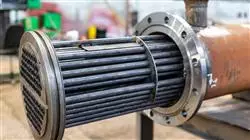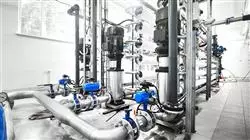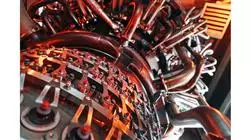University certificate
The world's largest faculty of information technology”
Introduction to the Program
Learn all kinds of CFD Techniques and get the most out of them, in just a few months"

The most widely used method in Computational Fluid Mechanics is the Finite Volume Method (FVM), but there are very suitable alternative techniques with specific applications that are very useful in this field. In order to get the most out of this series of techniques, specific and very advanced knowledge is required, which means that professionals in this area are increasingly in demand.
This is the reason why TECHTechnological University has created a Postgraduate diploma in Unconventional CFD Techniques, with the aim of providing its students with the most appropriate skills and competences to be able to carry out their work with the highest quality in their jobs. Thus, throughout the syllabus, topics such as the Finite Element Method, Direct
Simulation Monte Carlo (DSMC), Advanced CFD Models or Post-processing, Validation and Application in CFD, among other relevant aspects, are studied in depth.
All of this, in a 100% online modality that gives total comfort and freedom to the student, so that their usual activity is not interfered with, while they progress in their studies. Moreover, through the most complete multimedia materials, the most up-to-date information and the most innovative pedagogical tools on the academic market.
Enhance your knowledge in FEM, SPH or DSMC and gain new possibilities to succeed in this field"
This Postgraduate diploma in Unconventional CFD Techniques contains the most complete and up-to-date program on the market. The most important features include:
- The development of case studies presented by experts in Unconventional CFD Techniques
- The graphic, schematic, and practical contents with which they are created, provide scientific and practical information on the disciplines that are essential for professional practice
- Practical exercises where self-assessment can be used to improve learning
- Its special emphasis on innovative methodologies
- Theoretical lessons, questions to the expert, debate forums on controversial topics, and individual reflection assignments
- Availability to access content from any fixed or portable device with internet connection
Enroll now and get access to the most complete and up-to-date content on Unconventional CFD Techniques""
The program’s teaching staff includes professionals from the sector who contribute their work experience to this educational program, as well as renowned specialists from leading societies and prestigious universities.
Its multimedia content, developed with the latest educational technology, will provide the professional with situated and contextual learning, i.e., a simulated environment that will provide an immersive education programmed to learn in real situations.
The design of this program focuses on Problem-Based Learning, by means of which the professional must try to solve the different professional practice situations that are presented throughout the academic course. For this purpose, the student will be assisted by an innovative interactive video system created by renowned experts.
Thanks to TECH Global University, you will improve your skills in Multi-physics Simulations or CFD Post processing"

Access all the content from day one and a wide range of practical exercises to boost your knowledge"
Syllabus
The content of this Postgraduate diploma has been designed and structured by the experts that make up TECH Global University team of specialists in Unconventional CFD Techniques, resulting in complete and accurate content. All of this, under the most efficient teaching methodology, Relearning, which allows the student to assimilate the essential concepts in a natural and dynamic way, without having to dedicate too much time to study.

Thanks to the pedagogical methodology of TECH Global University Relearning, you will be able to acquire the essential concepts without spending too much time studying"
Module 1. Advanced Methods for CFD
1.1. Finite Element Method (FEM)
1.1.1. Domain discretization. Finite Elements
1.1.2. Form functions. Reconstruction of the continuous field
1.1.3. Assembly of the coefficient matrix and boundary conditions
1.1.4. Solving the system of equations
1.2. FEM Case Studies Development of a FEM simulator
1.2.1. Form functions
1.2.2. Assembling the coefficient matrix and applying boundary conditions
1.2.3. Solving the system of equations
1.2.4. Post-Process
1.3. Smoothed Particle Hydrodynamics (SPH)
1.3.1. Fluid field mapping from particle values
1.3.2. Evaluation of derivatives and particle interaction
1.3.3. The smoothing function. The kernel
1.3.4. Boundary Conditions
1.4. SPH: Development of a simulator based on SPH
1.4.1. The kernel
1.4.2. Storage and sorting of particles in voxels
1.4.3. Development of boundary conditions
1.4.4. Post-Process
1.5. Direct Simulation Monte Carlo (DSMC)
1.5.1. Kinetic-molecular theory
1.5.2. Statistical mechanics
1.5.3. Molecular equilibrium
1.6. DSMC: Methodology
1.6.1. Applicability of the DSMC method
1.6.2. Modeling
1.6.3. Considerations for the applicability of the method
1.7. DSMC: Applications
1.7.1. Example in 0-D: Thermal relaxation
1.7.2. Example in 1-D: Normal shock wave
1.7.3. Example in 2-D: Supersonic cylinder
1.7.4. Example in 3-D: Supersonic corner
1.7.5. Complex example: Space Shuttle
1.8. Lattice-Boltzmann Method (LBM)
1.8.1. Boltzmann equation and equilibrium distribution
1.8.2. De Boltzmann a Navier-Stokes. Chapman-Enskog Expansion
1.8.3. From probabilistic distribution to physical magnitude
1.8.4. Conversion of units. From physical quantities to lattice quantities
1.9. LBM: Numerical approximation
1.9.1. The LBM Algorithm. Transfer step and collision step
1.9.2. Collision operators and momentum normalization
1.9.3. Boundary Conditions
1.10. LBM: Case Study
1.10.1. Development of a simulator based on LBM
1.10.2. Experimentation with various collision operators
1.10.3. Experimentation with various turbulence models
Module 2. Advanced CFD Models
2.1. Multi-physics
2.1.1. Multi-physics Simulations
2.1.2. System Types
2.1.3. Application Examples
2.2. Unidirectional Co-simulation
2.2.1. Unidirectional Co-simulation Advanced Aspects
2.2.2. Information Exchange Schemes
2.2.3. Applications
2.3. Bidirectional Co-simulation
2.3.1. Bidirectional Co-simulation Advanced Aspects
2.3.2. Information Exchange Schemes
2.3.3. Applications
2.4. Convection Heat Transfer
2.4.1. Convection Heat Transfer. Advanced Aspects
2.4.2. Convective heat transfer equations
2.4.3. Methods for solving convection problems
2.5. Conduction Heat Transfer
2.5.1. Conduction Heat Transfer. Advanced Aspects
2.5.2. Conductive heat transfer equations
2.5.3. Methods of solving conduction problems
2.6. Radiation Heat Transfer
2.6.1. Radiation Heat Transfer. Advanced Aspects
2.6.2. Due to Radiation heat transfer equations
2.6.3. Methods of solving Radiation problems
2.7. Solid-fluid-heat coupling
2.7.1. Solid-fluid-heat coupling
2.7.2. Solid-fluid thermal coupling
2.7.3. CFD and FEM
2.8. Aeroacoustics
2.8.1. Computational aeroacoustics
2.8.2. Acoustic analogies
2.8.3. Resolution methods
2.9. Advection-diffusion problems
2.9.1. Advection-diffusion problems
2.9.2. Scalar Fields
2.9.3. Particle methods
2.10. Coupling models with reactive flow
2.10.1. Coupling models with reactive flow. Applications
2.10.2. System of differential equations. Solving the chemical reaction
2.10.3. CHEMKINs
2.10.4. Combustion: flame, spark, Wobee
2.10.5. Reactive flows in non-stationary regime: quasi-stationary system hypothesis
2.10.6. Reactive flows in turbulent flows
2.10.7. Catalysts
Module 3. Post-processing, validation and application in CFD
3.1. Post-processing in CFD I
3.1.1. Postprocessing on Plane and Surfaces
3.1.1. Post-Process in the Plane
3.1.2. Post-processing on surfaces
3.2. Post-processing in CFD II
3.2.1. Postprocessing Volumetric
3.2.1.1. Post-processing Volumetric I
3.2.1.2. Post-processing Volumetric II
3.3. Free CFD post-processing software
3.3.1. Free Postprocessing Software
3.3.2. Paraview
3.3.3. Paraview usage example
3.4. Convergence of simulations
3.4.1. Convergence
3.4.2. Mesh convergence
3.4.3. Numerical convergence
3.5. Classification of Methods
3.5.1. Applications
3.5.2. Types of Fluid
3.5.3. Scales
3.5.4. Calculation machines
3.6. Model validation
3.6.1. Need for Validation
3.6.2. Simulation vs Experiment
3.6.3. Examples of validation
3.7. Simulation methods. Advantages and Disadvantages
3.7.1. RANS
3.7.2. LES, DES, DNS
3.7.3. Other Methods
3.7.4. Advantages and Disadvantages
3.8. Examples of methods and applications
3.8.1. Case of a body subjected to aerodynamic forces
3.8.2. Thermal case
3.8.3. Multiphase case
3.9. Good Simulation Practices
3.9.1. Importance of Best Practices
3.9.2. Best Practices
3.9.3. Simulation errors
3.10. Free and commercial software
3.10.1. FVM Software
3.10.2. Software for other methods
3.10.3. Advantages and Disadvantages
3.10.4. CFD Simulation Futures

A Postgraduate diploma in Unconventional CFD Techniques, with a wide variety of additional material to study in depth those aspects that interest you most”
Postgraduate Diploma in Unconventional CFD Techniques
Numerical simulation and computational fluid analysis (CFD) are areas of great relevance in engineering and scientific research. At TECH Global University, a global leader in online education, our prestigious School of Computer Science offers you a state-of-the-art online classroom Postgraduate Diploma in Unconventional CFD Techniques, designed to provide you with specialized training in the latest techniques and methodologies used in fluid analysis and simulation in unconventional contexts. Thanks to our flexible and self-regulating lessons, exclusive multimedia content and innovative academic methodologies, you are guaranteed a highly prestigious qualification.
Thanks to our flexible and self-regulating lessons, exclusive multimedia content and innovative academic methodologies, you are guaranteed a highly prestigious qualification.
This online Postgraduate Diploma will allow you to delve into advanced CFD topics, such as multiphase flow simulation, turbulence modeling in complex flows, simulation of reactive flows, and the application of optimization techniques in fluid analysis. In addition, you will have specialized software tools and the guidance of experts in the field, who will accompany you in your learning process and provide you with the knowledge and skills necessary to face the professional challenges in this constantly evolving field. Enhance your CFD skills and stand out in your professional career with the Postgraduate Diploma in Unconventional CFD Techniques program at TECH Global University!







